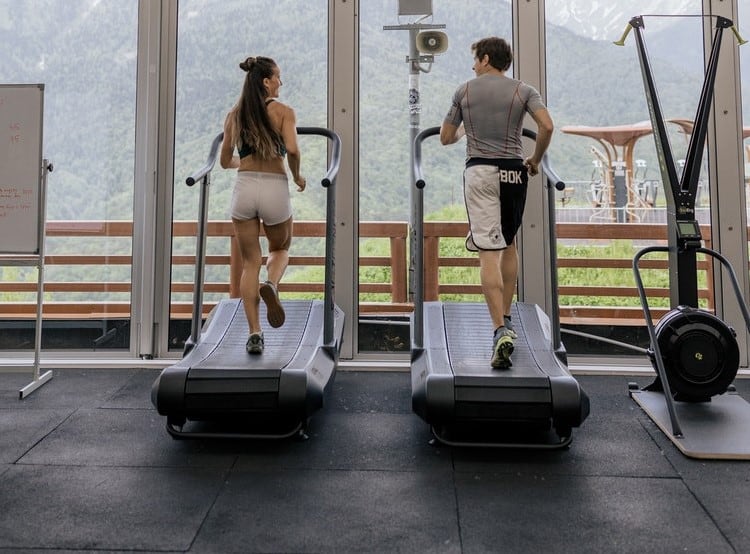The treadmill is one of the most common in-home exercise equipment for aerobic workouts ranging from walking to running. This is because it is excellent for cardio exercises which significantly benefit heart health, burn fats, reduce cholesterol and improve mood.

Treadmills are already a favorite because of their compatibility with most individuals, regardless of fitness level. So even when you don’t feel like working out outside in the cold or you need to dial in for a meeting, the treadmill is an excellent fit to hit daily steps goals while not neglecting other priorities.
The treadmill might be a better fit than running outdoors, depending on your lifestyle and work priorities, as you do not have to deal with unfavorable weather; also, you have full control over your routine. However, the question remains: how long should you run on a treadmill, and are there safety measures to be mindful of? So let’s get right into it.
How Long Should You Run on a Treadmill?
The only correct answer to this bordering question is: whatever amount of time suits your body’s ability. One can run for just 10 minutes for a quick morning refresh or boost or run for hours to train for a marathon, build endurance or burn body fat.
Your running duration on a treadmill should depend on your fitness goals. For example, how you run to build your fitness level will differ from when trying to burn off excess fats.
We’d examine a series of fitness goals and give you an insight on how to achieve them by running on a treadmill.
Weight Loss and Burn Fat
Running is an excellent exercise for weight loss. It helps you burn excess fats and maintain a healthy weight, especially if combined with a healthy dietary plan. If you have little or no experience with running or are working on the treadmill for the first time, you don’t have to force yourself. Just try to do what you are comfortable with; you can start a routine of slow pace runs set for 10 to 15 minutes, three days a week.
Note that you may not be able to run for the full time; you might have to switch to walking, then continue running after catching your breath. If you make this a routine, you will start to get more comfortable after a while. Then you can start adjusting to about 30 minutes runs four or five days a week. Adhering to an ideal routine with an improved eating plan will help you achieve your weight loss goals.
Improve Your Overall Body Fitness
If you want to improve your fitness level simply by running on a treadmill, you will need to run beyond a comfortable pace. You should be looking to exercise at a moderate to vigorous intensity level.

High-intensity interval training (HIIT) on treadmills is excellent for improving cardiovascular and overall body fitness. When on the treadmill, monitor how long you’ve been running, also the speed and intensity you are running.
A 20 to 30 minutes vigorous running routine four or five times a week is excellent for maintaining optimum body fitness levels.
In addition, brisk walking on the treadmill is also acceptable for seniors, including those with injuries and diseases like arthritis. It helps to strengthen the cartilages and aids in the circulation of the synovial fluid – responsible for nourishing the joints. However, a word of caution; the elderly and those with injuries may need to run slower. A short 5-20 minutes on the treadmill no less than twice a week should be effective.
Building Endurance for a Race or Marathon
Besides regular workouts, you can use the treadmill as your track to practice for a race. The treadmill allows you to simulate the kind of race – short and long- so that you can prepare ahead of the actual race.
- Short Race or Half Marathon
Perhaps you are participating in a weekend road race; the treadmill is an ideal place to improve your speed, especially if you want to compete. Let’s use the typical 5K road race as an example. To practice on the treadmill, you should set a finishing time goal. Then you work towards running at that pace.
The first thing to do is determine the time you take to complete a mile – say you spend 10 minutes. Then you should work towards maintaining that speed for the entire 5K race (3.1 miles). That is, your goal is to complete the race no later than 30 minutes. It’s best to run such a race at a steady speed.
As you prepare for the race, you should practice with a routine of running about two to five miles.
However, you can set up different goals for each practice day, such as running at a faster pace, slower, and your intended speed for the race. Therefore, you run on the treadmill for about 25 to 50 minutes during each practice.
- Long Race or Full Marathon
You’d have to run on your treadmill for longer durations when preparing for a long-distance race, such as a marathon. Since the event you are planning will take hours to complete, it’s best to prepare your body for the task ahead. Adequate preparation for a half marathon or a full marathon will require weeks of practice before the race.
For example, if participating in a half marathon with the intention of completing the event in 90 minutes, you’d need to stimulate your exercise to suit this purpose. Also, if your running location includes uphill and steep grounds, you should indicate that into your treadmill by adding a degree of incline. Though this will reduce your running speed, it prepares you for the task ahead.
Generally, the Physical Guidelines (for Americans) recommend engaging in moderate-intensity activity for 150 to 300 minutes a week or a high-intensity workout for 75 to 150 minutes a week. Note that you do not have to practice these exercises once. In fact, it is best to spread your exercise across the week, such as exercising five days a week.
So, if you are engaging in the 150 minutes moderate intensity run, you can spread it by doing a 30 minutes workout five days a week. You shouldn’t stick to a single routine to get the best outcome of your running routine for improved fitness. Instead, combine moderate and high-intensity treadmill routines throughout the week.
Running to Tone Up
Running is an excellent exercise for improving body shape and replacing fats with muscle mass – essentially toning up. We’ve discussed how it could help burn fats and maintain a healthy weight.

Running, especially HIIT on a treadmill for 30 minutes five days a week, can help boost your metabolism, shrink arms, increase thigh and calf muscles, tone your legs, and basically everything below the waist.
Also, it may help improve your sleep, which also plays a crucial role in your overall body tone.
Safety and Health Precautions
Treadmills can become dangerous if not properly used. Hence, the need to abide by some safety and health tips when running on this gear. Here are some safety tips to prevent accidents or injuries when running on the treadmill.
- Always look forward: Besides running on treadmills, this tip is also important when running on the roadside. Looking downwards or at your feet while running may cause you to lose balance. Therefore, it is crucial to keep your gaze forward when running.
- Don’t run barefoot: While running on the treadmill, friction between your feet and the moving belt causes heat. Therefore, unprotected feet may develop burns, blisters, or scrapes while running. Also, your feet can easily get stuck where the side of the moving belt meets, which can result in severe injuries. Generally, when running, exercisers should wear fitting cover shoes that protect the feet.
- Start the treadmill by straddling the deck: Runners shouldn’t start the device with their feet on the deck. Instead, they should straddle the deck. Regardless of the speed, often, the machine starts at a slow pace to allow the runner to build momentum before it attains the set speed.
- Increase Speed or inclination: Generally, it is difficult to maintain speed when running through a steep incline. So, depending on what kind of workout you plan, you should stick with either speed or incline. Increasing both can result in a fall, thereby causing an injury.
- Don’t step off a moving treadmill: Ensure to know where the emergency stop button is before attempting to run on a treadmill. Jumping off a treadmill in motion may be risky to you and those around you. It’s best to wait for the device to slow down and stop before stepping off.
Concerning the running duration on a treadmill, you mustn’t push your body too hard – know your limit! An excellent way to ensure this is to monitor your heart rate while running. If you push your body beyond its limit, you risk developing an injury or even a more severe health issue like a heart attack or stroke. Therefore, as you exercise, your health should remain a priority.
Another thing to note is warming up before running and cooling down after a workout.
Warming up allows you to loosen and prepare your muscles before the exercise. Before exercising, especially HIIT, you can engage in a 3 to 5 minutes warm-up routine on your treadmill where you set the pace to between 2.5 and 3.5 miles per hour. Once you feel warmed up, you can then slowly increase the speed.
Once you are done exercising, the next thing to do is to cool down. Just as you did while warming up, slowly reduce the speed – say every two minutes till it’s good enough to walk on the treadmill. Cooling down prevents you from abruptly ending your workout, thereby reducing breathing and heart rate to normal.
6 Benefits of Running on the Treadmill
The treadmill is easy to work with equipment for different exercises, like walking, jogging, or intense running. So without much ado, let’s quickly examine some of the benefits of working out with a treadmill.
- Full Control: The treadmill allows you to control all aspects of your exercise – speed, intensity, inclination, warm-up and cool-down periods, etc. You get to customize your exercise to fit your routine.
- Convenience: Running on the treadmill is an excellent alternative to running outdoors, which puts you at risk of assault or danger of robbery while also offering convenience. The device allows you to multitask – while running indoors, you do not miss out on your favorite TV shows or other priorities like keeping your kids company or cooking your favorite dish.
- Weather Proof: The treadmill also proves superior to running outdoors, as with this gear, unfavorable weather won’t restrict you from running. Since you are indoors, even if it’s snowing, raining, or sunny, you can still meet your daily exercise goals.
- Extra Health and Fitness Features: There are special treadmills with features that allow you to count the number of steps, and heart rates, which may prove beneficial for those on special fitness programs.
- Safety: Unlike walking or running on sidewalks, the treadmill has a smooth, predictable surface, hence fewer risk of tripping when running
- Permits Multiple Users: One treadmill is enough. It can serve multiple users without any special adjustments to the device.
Conclusion
There’s no specific schedule for running on the treadmill. Instead, stick to whatever amount of time you can sustain, especially when starting this workout routine. However, you should always remember that consistency is better than intensity. It’s better to spread your workouts across the week than squeeze them into the weekend or your favorite weekday.
